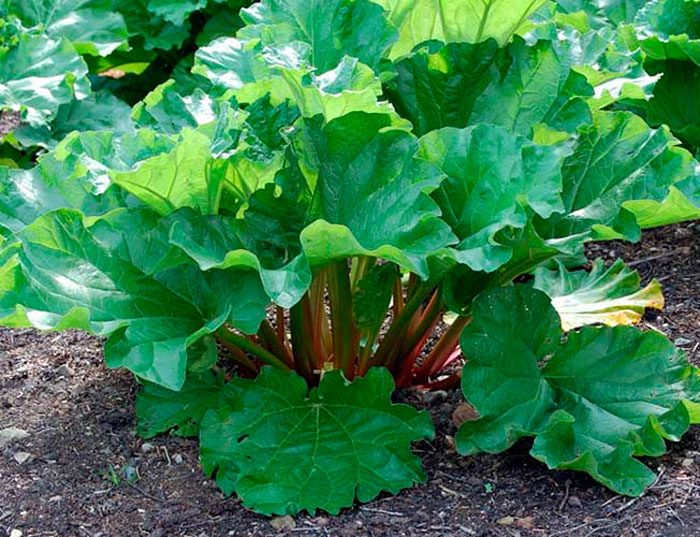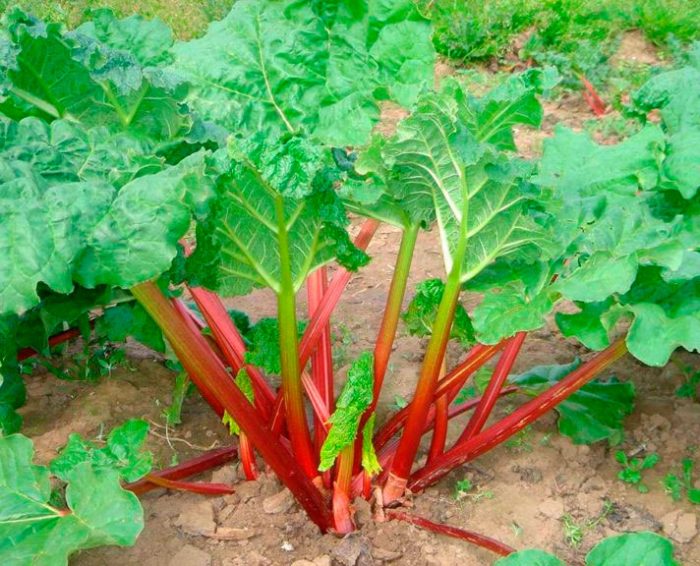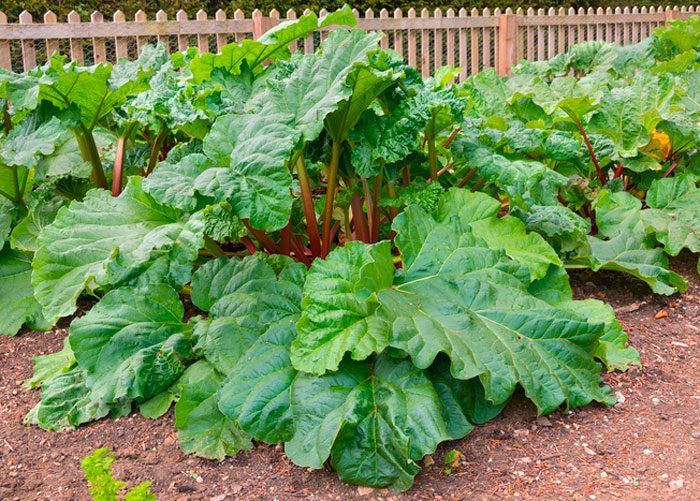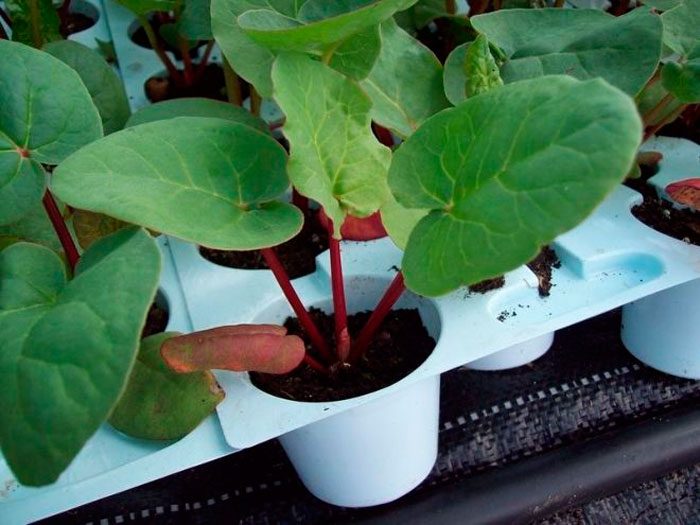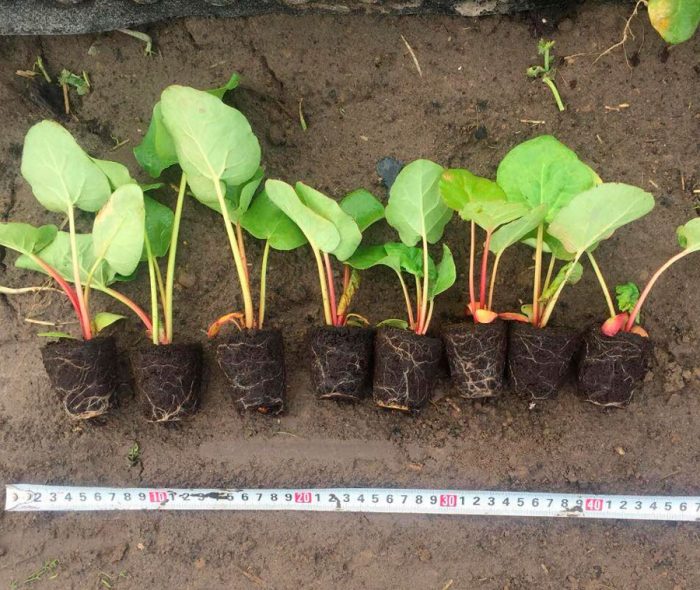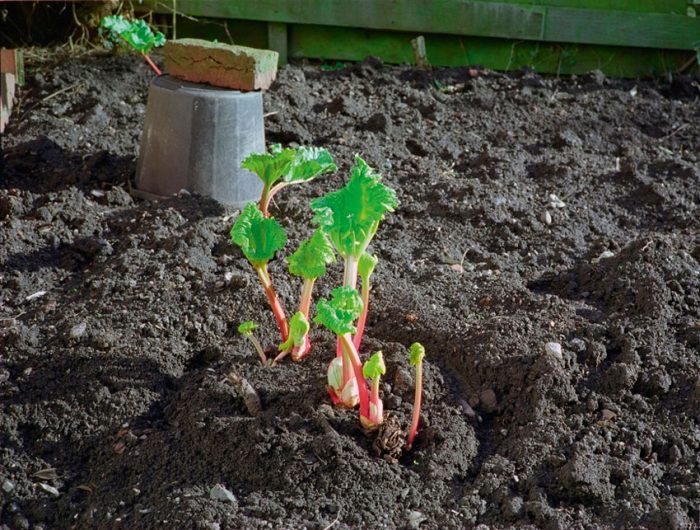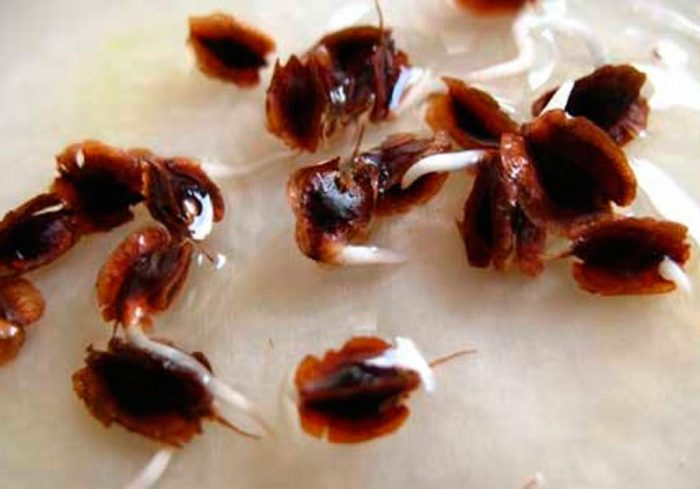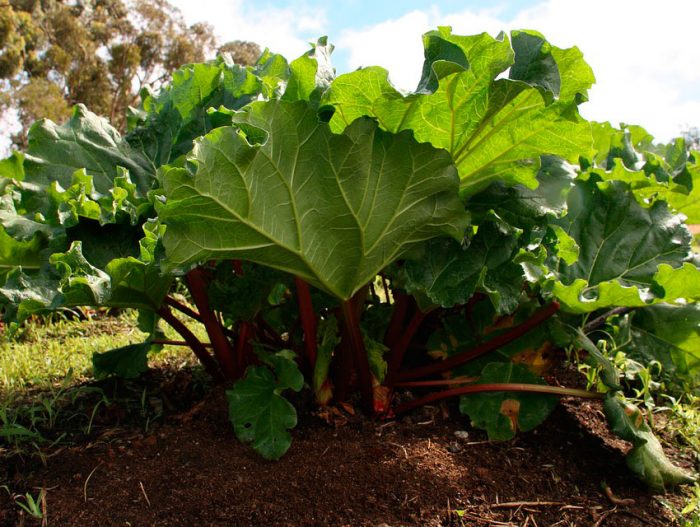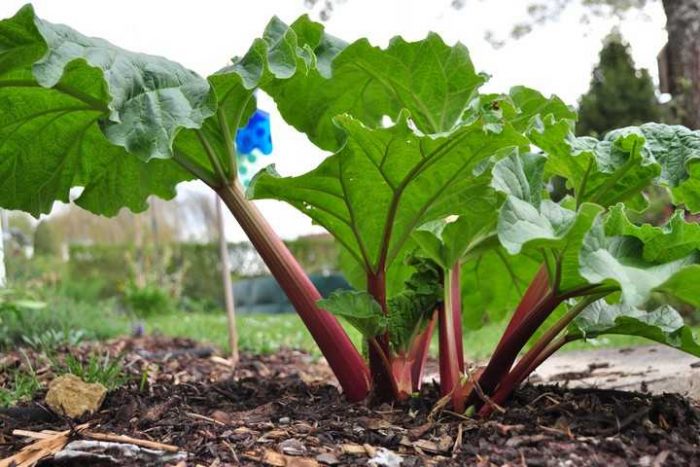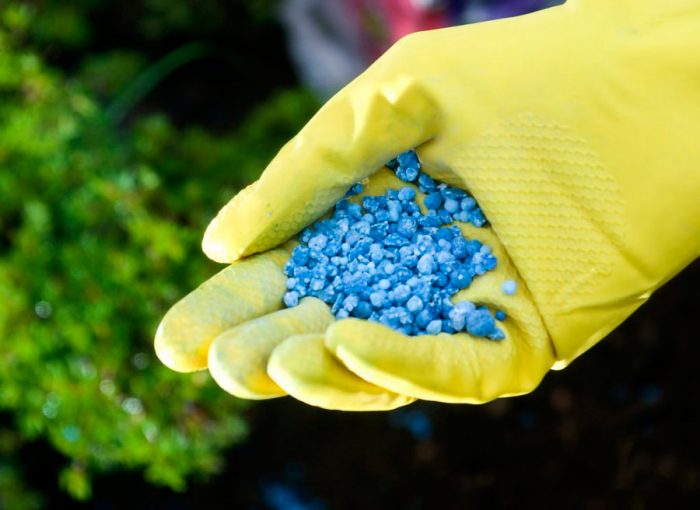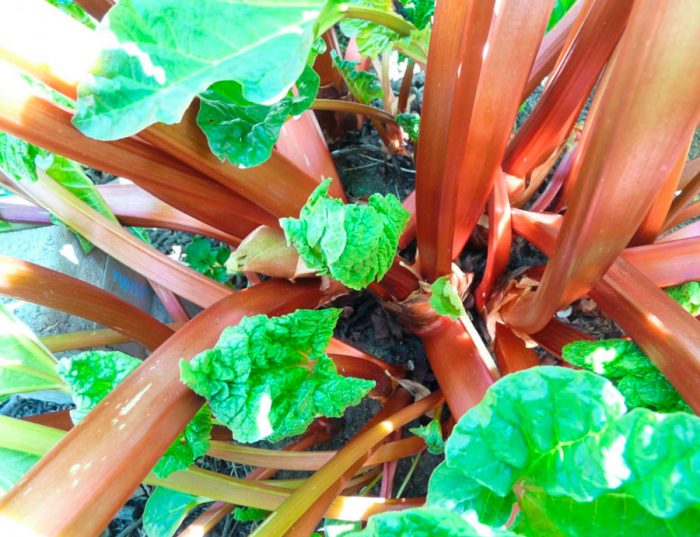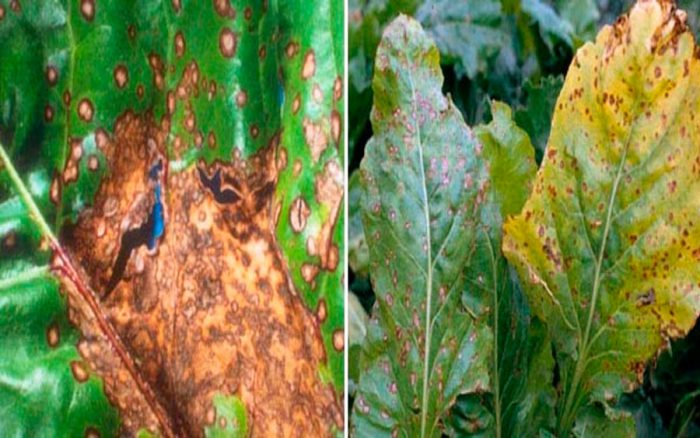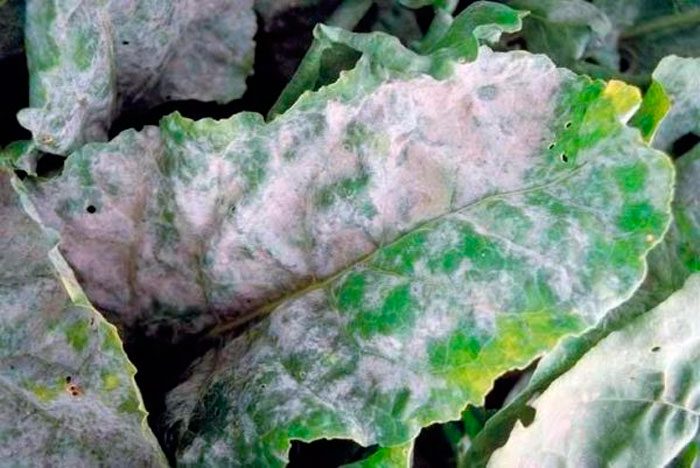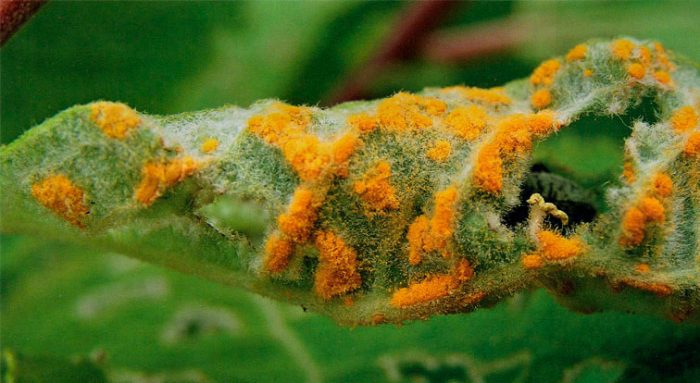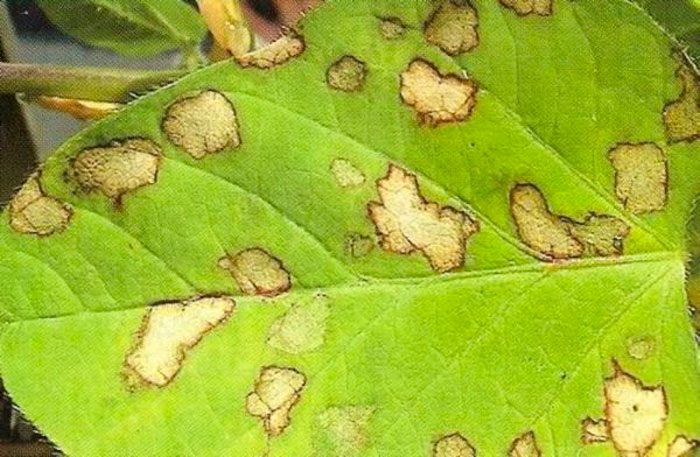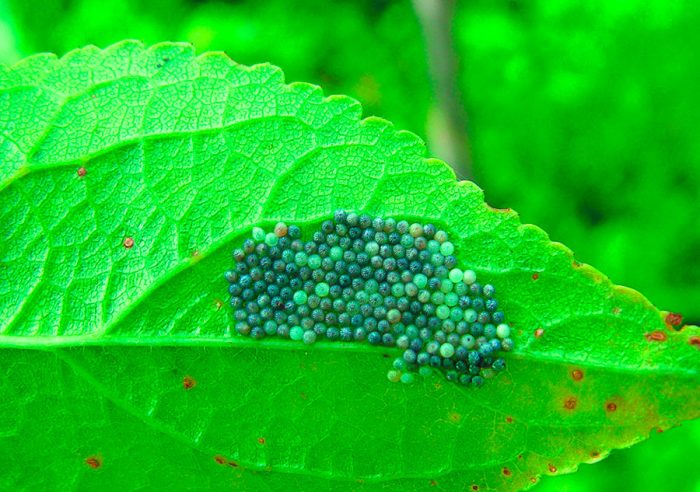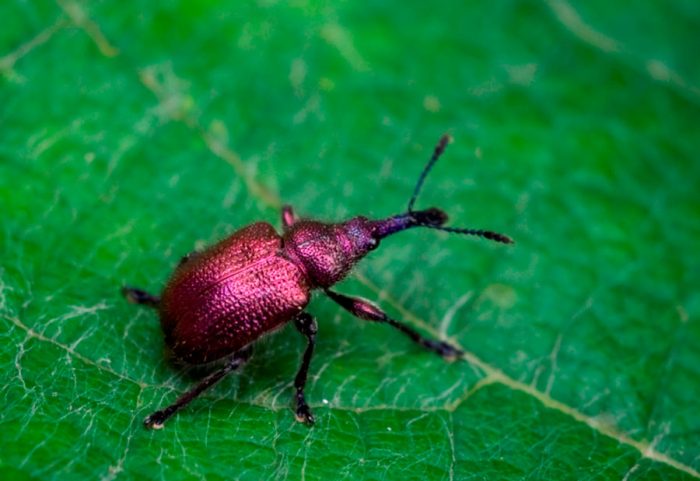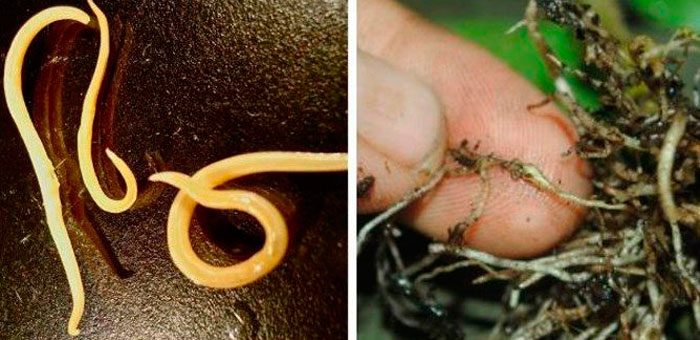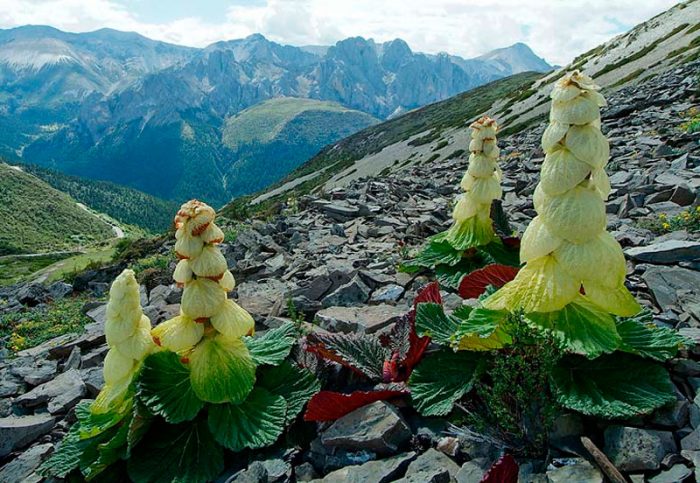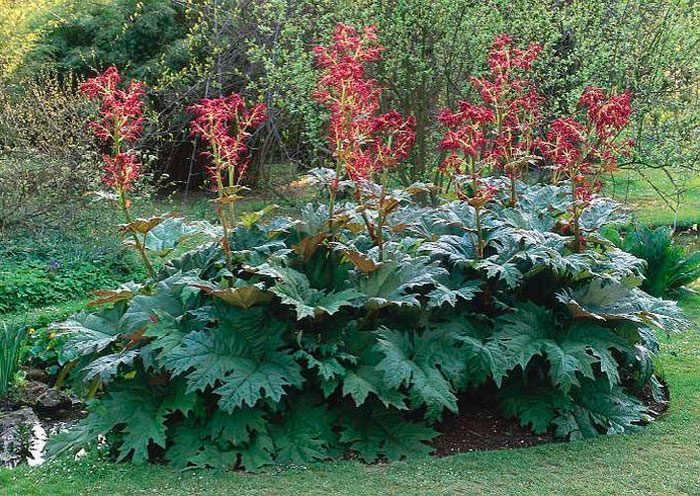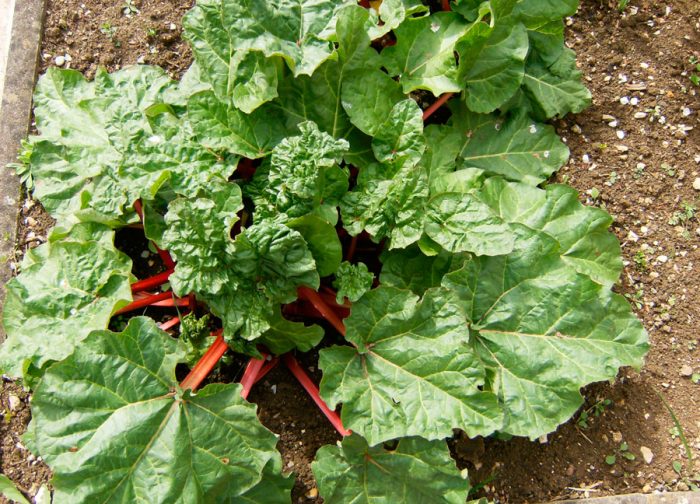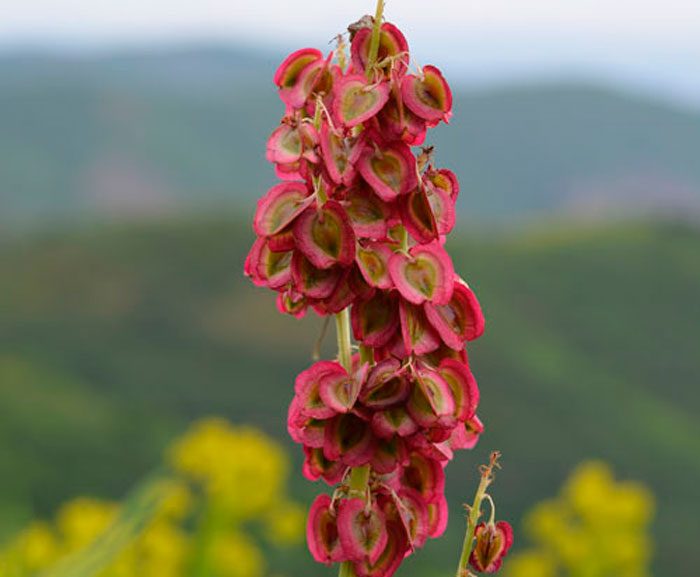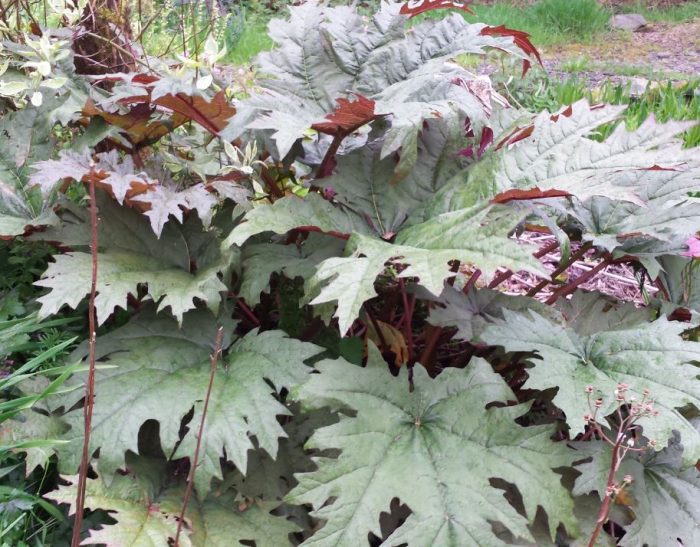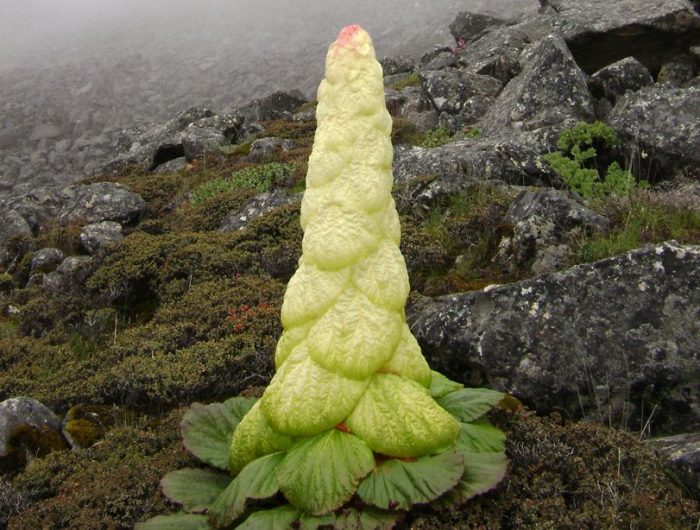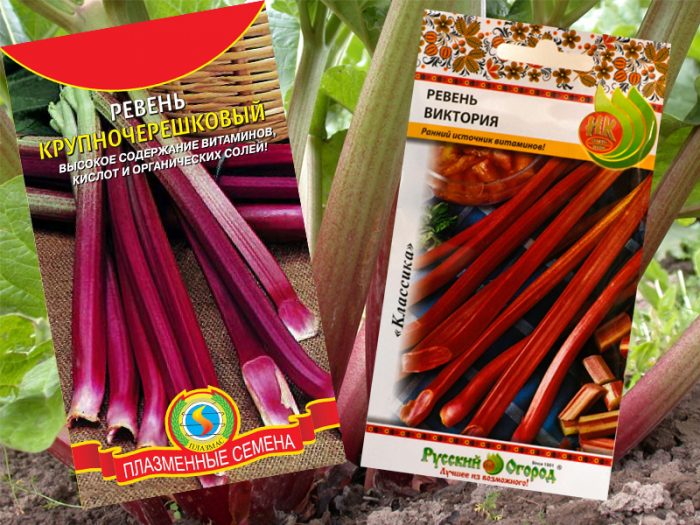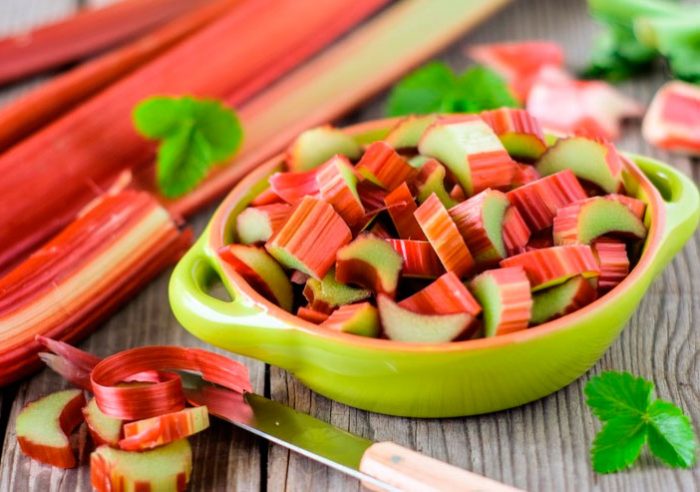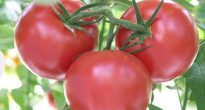Rhubarb (Rheum) is a herbaceous perennial that is a member of the Buckwheat family. This plant is most common in nature in the United States and Europe, but it can also be found in Asia. Rhubarb has a rather confusing origin story. A mention of him was found in the writings of Pedanius Dioscorides, who lived in the 1st century AD. On the territory of Europe from Asia through Persia, such a culture began to be imported in the 11-12 centuries. After Marco Polo visited the Tangut kingdom, he said that the root of this plant was grown and harvested there in large quantities. The rhubarb root came to England in 1640, it was imported from China through India, which is why the British called it a Chinese, Cantonese or East Indian vegetable. This culture came to the territory of modern Russia presumably from the Crimean peninsula.
Content
Brief description of cultivation
- Sowing... Sowing seeds in open soil is carried out in the first days of October or in February – March. And they are sown on seedlings in the first days of April, while the plants are planted in open soil in August or in the first days of September.
- Illumination... It grows well in a shaded and sunny place, as well as in an area with diffused light.
- Priming... A suitable soil must be water-permeable and moist, and must also contain a large amount of humus. The optimum pH is 4.5.
- Watering... Water should be plentiful and systematic. During the season, this procedure is carried out 3 or 4 times, while 3-4 buckets of water are consumed per 1 square meter.
- Fertilizer... During the summer period, rhubarb needs to be fed 1 or 2 times, for this use organic matter or mineral fertilizer. 1 time in 4-5 years, 1-2 buckets of humus should be added under each bush. It is recommended to feed rhubarb with organic fertilizers in autumn, and mineral fertilizers - in spring.
- Reproduction... By dividing the rhizome and by seed method.
- Harmful insects... Caterpillars of the heartworm, onion nematodes and rhubarb weevil.
- Diseases... Ramulariasis, ascochitis, powdery mildew and rust.
- Properties... The composition of such a plant includes biologically active substances, so it has healing properties.
Features of rhubarb
A woody, branchy rhubarb rhubarb of a dark brown color reaches 40–60 mm in diameter, on its surface there are many small roots. The lifespan of the root of such a plant is 12 years or more. Thick, hollow, straight, slightly grooved stems are annual. Large basal leaf plates are solid, palmate-lobed or toothed, they are often wavy along the edge. The foliage has long petioles, which are cylindrical or multifaceted, at their base there are wide sockets. Rosette leaf plates are much larger than stem plates. The stem is weakly branched and erect, its height is about 250 cm. On the surface of straight tall peduncles there are many red spots, they end in paniculate inflorescences, which include bisexual small flowers of pale green, red, white or pink. If the flowers grow underdeveloped, then they can be same-sex. Flowering is observed in the last days of May or the first - in June. The fruit is a brownish-red triangular nut, the length of which is from 70 to 100 mm. The root of such a plant has medicinal properties, as well as its leaf petioles.
Sowing rhubarb seedlings
When to plant rhubarb seedlings
Rhubarb can be grown from seeds, but this process is quite laborious, and the resulting plants will give the first harvest only after a few years. However, this method allows you to have a tasty and healthy vegetable on your table for many years. Seed material can be purchased at specialized agricultural stores, you can also buy it in the online store, but it must be reliable and with a good reputation.
Seed preparation should be done four days before sowing day. To do this, they are poured with water at room temperature, where they will swell for 10 hours. Then they are immersed for 1 hour in a solution of potassium manganese of pink color for disinfection. After that, the seed is transferred to a moistened cloth, and all that remains is to wait for the seeds to bite.
Sowing for seedlings is carried out in the first days of April; for this, pots are used, reaching 10-12 centimeters in diameter. It is necessary to deepen the seeds into the substrate by 20-30 mm. Before the seedlings appear, you need to make sure that the soil mixture in the containers is constantly slightly damp.
Rhubarb seedling care
The appearance of the first shoots is observed 15–20 days after sowing. As soon as this happens, the pots with plants must be immediately rearranged in a well-lit place. It is quite simple to grow rhubarb seedlings, for this you need to water it in a timely manner, loosen the surface of the soil mixture, and also feed it regularly (once every 1.5 weeks).
You need to take care of the plants throughout the summer. They are transplanted into open soil only after 90–100 days from the moment of sowing the seeds, as a rule, this time falls on August or the first days of September. The fact is that the planted seedlings must have time to take root well before winter comes.
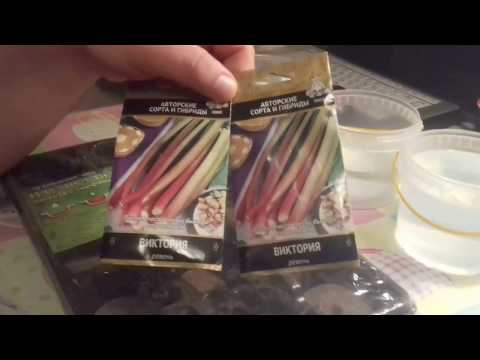

Watch this video on YouTube
Growing rhubarb from seeds in the garden
Planting rhubarb in the ground
Since rhubarb is distinguished by its frost resistance, its seeds can be sown directly into open soil. But when is the best time to do it? Sowing seeds is carried out at the beginning of the spring period (in March, and possibly in February). This can also be done before winter in mid-October. Such a culture is not only frost-hardy, but also unpretentious, so it is quite easy to grow it on your site.
For sowing, you can choose both a well-lit secluded corner in the garden, and a shaded area under the canopy of fruit trees. Suitable soil should be moist, water permeable, contain a large amount of humus and have an acidity of pH 4.5. The preparation of the site needs to be done a few months before sowing, for this, it is dug up with the introduction of humus into the soil (3 buckets per 1 square meter of the site). In the same place, such a crop can be grown for 15 years or even longer.
Sowing rules
To begin with, the seed must be prepared and germinated, they do this in the same way as when sowing rhubarb for seedlings (see above). Then the seeds are densely laid out in prepared grooves, the depth of which is 10-15 mm, the distance between them should be from 20 to 25 centimeters. Then the seeds are covered. If podzimny sowing is carried out, then the bed should be mulched with garden compost, leaf humus or other organic material, while the layer thickness should be about 10 mm. If the sowing was carried out in the spring, then it will be necessary to mulch the garden bed only after the seedlings appear. You also need to mulch the garden bed and immediately after transplanting the seedlings into open soil.
Even with spring sowing, even with podzimnuyu sowing, the first shoots can be seen only in spring, while it must be borne in mind that the seed material of such a plant has a low germination capacity. From mid to late May, when 1 or 2 true leaf plates are formed on the plants, the plant will need to be planted, adhering to the scheme of 10x10 centimeters.


Watch this video on YouTube
Rhubarb care
Caring for rhubarb crops before the onset of the autumn period consists in systematic watering, timely removal of weeds, loosening the soil surface around the bushes, and also once every 1.5 weeks they need to be fed with complex mineral fertilizer. With the beginning of the autumn period, rhubarb is stopped to water and feed, and at this time you should start transplanting seedlings to a permanent place, but some gardeners prefer to grow them in a school for another 1 year. When transplanting seedlings to a permanent place, it should be remembered that the feeding area for one bush should be at least 1 square meter.
How to water
To make the petioles large, the bushes need to be watered systematically and abundantly. During one season, such a culture is watered 3 or 4 times, while 3 to 4 buckets of water are consumed per 1 square meter of the plot. The less frequent and scarce watering is, the more oxalic acid will be contained in the petioles.
After the flower stalks are formed on the bush, they should be removed. The fact is that due to the growth of peduncles, foliage and petioles develop and grow much more slowly. When rhubarb is watered, it is recommended to loosen the surface of the soil around it, while pulling out all the weeds.
Feeding rhubarb
During one season, such a plant will need 1 or 2 feeding with a liquid complex mineral or organic fertilizer, for example, you can use a mullein solution (for 1 bucket of water, 0.5 liters of mullein). In addition, 10–20 liters of manure or humus must be applied under each bush once every 4 or 5 years. In spring, it is recommended to use mineral fertilizers to feed this crop, and in the autumn, organic matter is better suited for this.
Wintering
In the summer, the bush should be rejuvenated, for this you need to cut off all the foliage with cuttings, while leaving only 2 or 3 leaf plates so that the rhubarb can eat normally. By autumn, foliage will grow again on the bush, while 1/3 of them can be cut off for food, and 2/3 of the leaf plates must be left on the plant, in which case it will be able to properly prepare for wintering. To protect rhubarb from freezing, it must be covered from above with dry soil or loose leaves.With the onset of spring, the shelter from the plant is removed so that it can grow foliage.
Rhubarb pests and diseases with photos and names
Rhubarb disease
More recently, experts believed that rhubarb has a very high resistance to all diseases and harmful insects, but it turned out that if such a crop is taken care of incorrectly, then it can get sick. Most often, this plant suffers from ascochitis, rust, ramulariosis and powdery mildew.
Ramulariasis
Ramulariasis is a fungal disease, specks of brownish-red color appear on the surface of the foliage of the affected bush with a dark red border. Over time, the spots become larger, and they merge with each other, while their middle gradually turns pale. During drought, cracking and eruption of tissue is observed inside the spots, while in wet weather a powdery coating of gray-silver or white color appears on their surface. The disease develops most actively when plantings are thickened, especially in humid and hot weather. For the purpose of prevention, the site must be cleaned of plant residues in the autumn, then its surface must be sprayed with a solution of Bordeaux mixture (1%) or another agent that contains copper.
Powdery mildew
On the foliage of a bush affected by powdery mildew, a loose bloom of a whitish color forms, as the disease progresses, it thickens and changes its color to brown. The first signs of damage to the plant by this disease can be detected at the beginning of the summer period. As a result, in those parts of the bush that are affected, there is a cessation of growth, blackening and death of diseased parts, no ovaries are formed on the inflorescences. Such rhubarb loses its frost resistance. To get rid of this disease, you need to use the same methods and drugs as in the fight against ramulariasis. Such biofungicides as Gamair, Alirin-B, Planriz, etc. show the greatest efficiency in the fight against such a disease.
Rust
If rhubarb is affected by such a fungal disease as rust, then pustules appear on the surface of its foliage, when they crack, a rusty powder spills out of them, which is a spore of the fungus. In such a plant, metabolic processes are affected, as well as a decrease in growth. After the affected foliage is cut off, the bush will need 2 or 3 treatments with Topaz with a break of 1.5 weeks.
Ascochitosis
Because of ascochitis, large spots of ocher-brick color are formed on the foliage, their shape is irregular and elongated. In places where the spots are located, cracking, drying out and rash of tissues are observed. Sick bushes will need to be sprayed with a solution of Bordeaux mixture (1%).
Before proceeding with the processing, it must be borne in mind that in rhubarb in the foliage, shoots, petioles and in the root system, toxins and poisons accumulate, therefore it is not recommended to spray it with fungicides. You can replace chemicals in the fight against fungal diseases with mullein infusion. In order to prepare it, a bucket is filled by a third with fresh cow dung, then cold water is poured into it, so that it becomes full. The mixture will be ready after three days, while it must be stirred from time to time. The infusion filtered through a dense fabric must be mixed with water in a ratio of 1:10, in the evening after sunset the bush is sprayed with this composition.
Rhubarb pests
This plant can be damaged by onion nematodes, caterpillars of the heartworm, and also rhubarb weevil.
Scoop eggs
The moths lay their eggs near the rhubarb, where the eggs hibernate. In spring, caterpillars of a yellow or off-white color appear from them, reaching 4.5 cm in length, they bite into the petioles and shoots and feed on the pulp of the plant.There is a gradual drying of the damaged tissues, while the caterpillars move into still whole petioles. In order to clear the area of such a harmful insect, it is necessary to remove the affected parts of the bush as soon as possible, and also to clear the area of weeds, because the scoop prefers to arrange its egg-laying near it.
Rhubarb weevil
The rhubarb weevil is a beetle, the length of which is about 0.6 cm, on the surface of its elytra there is a layer of scales of brown and grayish color. Such pests eat rhubarb foliage, while they arrange their egg-laying in leaf petioles. Legless, dirty yellow larvae hatch from the eggs, which live on foliage, eat it and pupate there. To scare off such a pest, it is necessary to spray the bush with a solution of potassium manganese (5 grams for 1 bucket of water).
Onion nematodes
Onion nematodes, which are microscopic worms, live in the petioles, foliage and shoots of the plant. As a result of their vital activity, rhubarb tissues soften and swell, and this leads to the death of the bush. To date, there are no effective measures to combat such a pest, in this regard, the affected plants must be dug up and destroyed as soon as possible, and in the area where they grew, nothing can be grown for at least a couple of years.
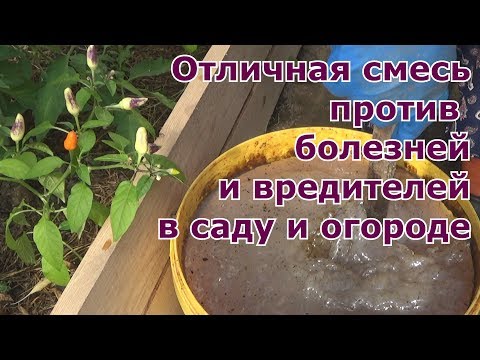

Watch this video on YouTube
Types and varieties of rhubarb with photos and names
More than 20 species of rhubarb are found in natural conditions. In addition to species plants, today there are a large number of varieties and hybrids. Below will be described those species that are most popular with gardeners.
Altai rhubarb (Rheum altaicum)
Or compact (Rheum compactum = Rheum orientale). The height of the bush varies from 0.3 to 1.2 m. The stem is hollow and thick, and the root is very thickened. The rosette leaf plates have long petioles and are ovoid-rounded or almost rounded; at the base they are deeply cordate. The surface of such leaves can be flat or slightly wavy, they reach 0.6 m in diameter. There are few upper leaf plates, they are smaller in comparison with rosette ones and, being short-petiolate, grow on stems.
Tangut rhubarb (Rheum tanguticum)
The height of such a perennial plant is about 2.5 meters, and the diameter of its spreading crown is up to 1.5 meters. The crown consists of large, long-petioled leaf plates of a finger-split shape. The length of the panicle inflorescences is about half a meter, they include yellow-green flowers.
Common rhubarb (Rheum rhabarbarum), or wavy, or Siberian
In this species, unlike others, the leaf plates are curly. Young leaves are very wrinkled, but after full blooming, they become wavy, as if decorated with ruffles along the edge. The foliage reaches 0.7 m in length and 0.5 m in width. Such a plant looks very impressive during flowering. Panicle inflorescences are formed on peduncles about 1.5 m high, they are composed of pale yellow flowers.
Wittrock's rhubarb (Rheum wittrockii)
In comparison with other species, this one has a not very large bush. The shape of the leaf plates is ovate-triangular, their length is about 0.5 m, and their width is up to 0.4 m. Foliage folded along the edge has short petioles, on the surface of which there is pubescence. The spreading panicle inflorescence consists of flowers of pale pink or white color.
Rhubarb (Rheum palmatum)
The homeland of this species is the mountainous regions of South and West China. Such a perennial plant has a large root and a ribbed bare stem of a light red color, the height of which is about 200 cm.The root rosette consists of very large five-seven-lobed leaf plates, at the base they are heart-shaped, and their diameter is about 0.8 m The alternate stem leaf plates are practically sessile.During the disclosure of the foliage, it has a purple color, then it changes to almost purple, but already in July the plates become dark green, only their seamy surface remains pale red. The length of the panicle inflorescences is about 0.5 m, they consist of flowers of pale pink, white-green or light red. This species has been cultivated since 1763. It has a very popular variety - Atrosanginium: the color of the petioles, foliage and shoots is purple.
Rhubarb (Rheum officinale)
The homeland of this kind is Tibet. The height of this perennial plant is about 2.5 meters. Three to four-lobed very large leaf plates have a green color, their length is about 150 cm, while the petioles reach about 100 cm in length. The peduncle is about 2 m long, a large half-meter long panicle, consisting of small greenish flowers, grows on it. In Europe, this species has been cultivated since 1871.
Rhubarb noble (Rheum nobile)
In natural conditions, this species can be found at an altitude of about 4500 meters. The height of the bush is up to two meters. The rosette consists of large bare leaf plates, the shape of which is ovoid. Paniculate inflorescences of greenish-yellow color almost sit on a flat rosette.
In addition to these species, rhubarb such as Maksimovich, ribez, Black Sea, Alexandra and Delaway are also cultivated.
All varieties of rhubarb are divided into early ripening, mid-ripening and late-ripening. The most popular are the following early maturing varieties:
- Altai dawns... The variety has a spreading rosette, consisting of large leaf plates, their long red petioles have excellent taste, and they weigh 80-120 grams.
- Victoria... This is a series of early maturing varieties distinguished by their productivity. Compact rosettes can be large or medium in size, they include leaf plates broadly ovate or ovoid, greenish slightly ribbed petioles have a red base, their length is 33-50 centimeters.
- Large petiolate... The variety is resistant to frost and disease. Up to the middle of the length, the petioles are red, and in length they reach 0.65–0.7 m, while their thickness is up to 30 mm. The sweet and sour flesh of the petioles is greenish, often with pink spots on it.
- Stubborn... Such a bush has a high and spreading leaf rosette. The foliage has large greenish petioles, at the base with an anthocyanin coloration, their length is about 0.55 m, and they weigh up to 180 grams.
- Moskovsky 42... The variety is distinguished by its yield and stemming resistance. Large smooth wavy leaf plates have long, slightly ribbed petioles, the flesh of which is greenish.
- Zaryanka... The spreading leaf rosette consists of plates growing on spectacular cherry-colored petioles, the length of which is about 0.45 m, their flesh is pink-green, sweet-sour taste.
The following medium-ripening varieties are most popular with gardeners:
- Obsky... This variety is distinguished by its frost resistance and moisture-loving nature. The rosette consists of slightly corrugated large green leaf plates, which reach about 1.2 m in diameter. The thick and long petioles are dark pink at the base, their delicate flesh has a sweet-sour taste.
- Tukumsky 5... Large dark green leaf plates are wavy along the edge, they grow on rounded greenish petioles with crimson pigmentation, their length is up to 0.5 m.
- Ogre 13... Such a productive variety is resistant to shooting. The height of the bush is about 0.8 m, its compact rosette consists of large leaf plates of a dark green color. The slightly ribbed petioles at the base are colored dark red, their length is about 0.7 m, and they reach about 40 mm in diameter, some of them can weigh about 0.35 kg. The taste of the petiole pulp is very high.
- Candied... Wide large petioles weigh about 200 grams, their very tasty pulp has a light pink color.
- Cyclone... The variety differs in that it rapidly grows medium-sized leaf plates, which have large green petioles and medium thickness, their flesh is tasty, sweet-sour.
The most popular are the following late varieties:
- Gigantic... The variety is resistant to disease. Delicious fragile long petioles are colored dark red.
- Goliath Series... This is a fruitful variety for canning purposes. The bush is tall, large and spreading. Bubble wide sheet plates have a wavy edge. Grooved petioles of green color can sometimes be speckled at the base. The flesh at the petioles is dense and green.
- Red peted late... The height of a compact bush is average. The leaf plates, wavy along the edge, have a half-meter length of the petiole of a deep red or dark red color, their thickness is about 30 mm, their flesh is red-pink or red.
Properties of rhubarb: harm and benefit
Useful properties of rhubarb
For food, rhubarb stalks and its young leaf plates are used, which have a slightly sour, slightly refreshing taste, since they contain malic and citric acid. The petioles also contain carbohydrates, vitamins C, PP, group B, fiber, pectins, carotene, magnesium, calcium, potassium and phosphorus salts.
Eating such a plant in food has a beneficial effect on the activity of the kidneys and intestines. It is recommended to eat it with low acidity, and it has also proven to be effective in treating wounds, colds, runny nose, purulent formations, burns and sinusitis. It contains biologically active substances that help strengthen myocardial muscles, significantly reduce the risk of stroke, prevent the development of cardiovascular diseases and cure heart failure.
The fact that rhubarb has healing properties has been known for a long time. Preparations made on the basis of the rhizome of such a plant are distinguished by powerful healing properties, so in small doses they have an astringent effect, and in large doses they act on the body as a laxative. Doctors recommend using such drugs for people suffering from flatulence, constipation or intestinal atony. But in the presence of hemorrhoids, such funds cannot be used. In small doses, this agent is used as a choleretic agent (at a dosage of 0.1–0.5 grams) or as an antidrug (0.2–0.8 grams). This drug is also prescribed in small doses as a tonic for anemia or tuberculosis. You can also strengthen the body by drinking ½ glass of the juice of such a plant three times a day. This plant is also used topically to help get rid of the white spots on the skin caused by vitiligo. In alternative medicine, laxatives and rhubarb teas are widely used. It is also used as a powder, syrup, infusion, decoction or tincture for alcohol or wine. In the pharmacy, if you wish, you can buy such a plant in the form of tablets, alcohol tincture, powder or extract.


Watch this video on YouTube
Contraindications
Since such a plant contains acids that contribute to the formation of stones in the bladder and kidneys, people with urolithiasis and gallstone diseases should not eat it. It also cannot be eaten by people with pancreatitis or with high acidity of the stomach. It should also be remembered that rhubarb promotes blood thinning, so it should not be used for bleeding and hemorrhoids.

